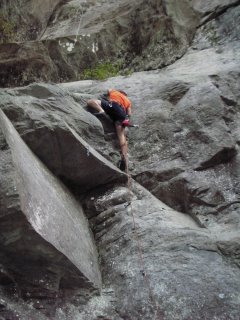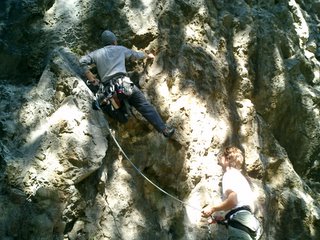This post is intended as both a summary of my climbing experiences in Kyushu and a guide for future climbers who might end up here*. It assumes that the climber is based in Saga-ken, Japan.
Most rock climbing areas in Kyushu offer single pitch sport routes. For those living in Saga-ken, there are several rock climbing areas that are easily accessible. With the exception of the rainy season, you can climb all year. Japanese climbers are generally sociable and safety conscious. Climbing gear can be purchased at Base Camp in Saga City (west of kencho on Route 207). Unless otherwise noted, each crag is some type of metamorphic rock.
Nodake
Nodake is located in Nagasaki-ken, between the city of Omura (Nagasaki-ken) and Kashima (Saga-ken). A small mountain road off Route 444 provides access. Nodake has routes ranging from 5.7 to 5.13 in difficulty. The biggest concentration of climbs is in the 5.11 range. All routes are bolted and the rock is generally of good quality. Shade cover abounds and some routes can be climbed even when it’s raining. Water available.
Ryutosen
 Ryutosen
Ryutosen Ryutosen is located in Nagasaki-ken. It’s only a 20-minute drive from the town of Ureshino, Saga-ken. It’s another sport climbing area with a concentration of difficult 5.11 and 5.12 climbs. Four separate climbing areas exist. Great swimming in a waterfall-fed series of pools. Bring water.
Taku High School
Taku High School has an outdoor climbing wall as well as an indoor bouldering gym. The wall is open to the public free of charge on Wednesday and Friday evenings. You’ll need to bring your own rope.
Azumaya
Azumaya is a small climbing area with a dozen short routes. Most of the routes are characterized by dime ledges that require precise edging and painful crimping. It’s close to anyone living in eastern Saga. Bring water.
Hiraodai
This is a small climbing area outside of Kitakyushu-shi. There are about 25 routes here. Because of the lack of shade cover, climbing here in the summer is not recommended. The rock is a coarse limestone; expect abrasions on the hands especially. Lots of cracks, holes, chicken heads, and other features. Also bouldering nearby. There is also a famous cave here that you can enter for a small fee. Bring water.
Hyugami

Hyugami is located in Fukuoka-ken, near the border with Oita-ken. It’s about 25 kilometers from the town of Yame on Route 442. Hyugami has several distinct climbing areas consisting of single and multi-pitch sport routes, slabs and aid routes (fixed pro). Be careful, as some of the pro dates back to the 80s (and beyond!). There’s an abandoned campsite that climbers use to spend the night. Bring water.
Honjo
 Honjo
HonjoThis limestone climbing area is located in southern Oita-ken. There are a total of four climbing areas totaling about 100 routes. Solid range from beginner to advanced, but definitely heaviest in the 5.11 and 5.12 range. The rock is a bit chalky but is good quality, with lots of holes, cracks, and other features. Good swimming during the summer. Great onsen nearby for those cold nights. Bring water.
Hachimenzan

Hachimezan can be found outside of Nakatsu-shi in northern Oita ken. There are three climbing areas, two of which face the south (lots of sunshine = good for winter, bad for summer). There are about 100 routes in total, the majority of which are rated in the 5.10s and 5.11s. Hard rock but not painful on the hands. Bouldering is also possible at several other locations on the mountain. Some spring water available but not guaranteed.
Hiezan, Okue-san and Hokodake
These areas are in the Shishigawa Valley (pop. 60) in central Miyazaki-ken, not far from Nobeoka-shi. It is quite possibly the most beautiful place in all of Kyushu. These are multi-pitch alpine routes and should only be attempted by those who have done this style of climbing. Better yet, go with someone who’s climbed here before. Expect fewer bolts and questionable anchors. Rock is granite and of great quality(For a trip report, click here: http://strandedontheisledekyushu.blogspot.com/2005/09/ascent-of-hiezan.html). Great swimming and hiking is possible as well. Water is available and some food (a bit pricy) can be bought at the only grocery store in 20km. Might be a good idea to bring your own food in case they decide to close early or not open at all.
Kiara, near the summit of Hokodake

Other
This guide is by no means comprehensive. There are rumors of decent sport climbing in Kagoshima. Yakoshima, off the coast of southern Kagoshima, has some hardcore multi-day alpine routes. Kumamoto supposedly has some great bouldering, as does parts of Fukuoka. If you have any details on these areas that you’d like to share, or if you need more specific beta, please contact me by leaving your e-mail address in the comments section.
*Disclaimer: Rock climbing is inherently dangerous. Stupid people die stupid deaths. You and you alone (i.e. NOT ME) are responsible for your safety while climbing here in Kyushu or anywhere else. Climb hard, but climb at your own risk.
No comments:
Post a Comment